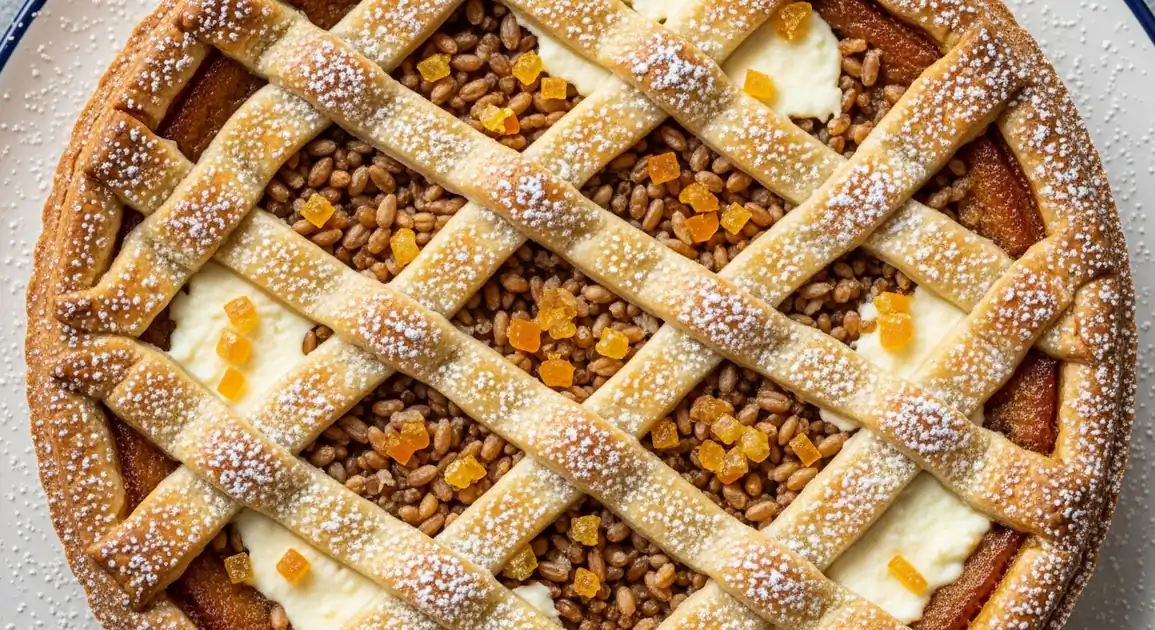Pastiera Napoletana (Neapolitan Easter Pie)
Pastiera Napoletana

Description
Naples is the undisputed homeland of pastiera, where this dessert transcends mere food to become a cultural institution. In this vibrant southern Italian city, pastiera represents centuries of tradition, with recipes handed down through generations. During Easter, nearly every pasticceria proudly displays their version, though many acclaimed establishments offer it year-round due to its enduring popularity among both locals and visitors seeking authentic Neapolitan flavors.
Dietary Information
Serving information
Serving style
In Naples, pastiera is served exactly as is, at room temperature, with at most a light dusting of powdered sugar. It's cut into modest triangular slices and typically enjoyed with espresso or sweet dessert wine like Passito.
Quick facts
Neapolitan pasticcerie typically open early (6:30 AM - 8 PM), with some closing briefly in the afternoon (1:30 PM - 4 PM).
Safety Tips
What to Look For
-
Purchase from established pasticcerie with good reputations
Traditional pastry shops with long histories of making pastiera typically follow proper food handling and traditional recipes.
-
Proper storage conditions
Pastiera should be displayed in clean cases, ideally refrigerated or in a cool environment if being sold during warmer months.
-
Fresh appearance without cracks or dried edges
The filling should look moist but set, without excessive dryness or cracks which indicate it's been stored too long.
-
Ask when it was made
Ideal pastiera should be 1-3 days old, which allows flavors to develop while remaining food-safe.
What to avoid
-
Mass-produced versions with artificial ingredients
Industrial pastiera often contains preservatives, artificial flavors, and lower quality ingredients that affect both taste and potentially digestibility.
-
Very old pastiera
While pastiera should rest 1-2 days, anything older than a week may have food safety concerns, especially if not properly refrigerated.
-
Improperly stored pastiera in warm environments
Pastiera contains eggs and dairy which can spoil if left at warm temperatures for extended periods.
-
Unusual colors or appearance
Traditional pastiera has a light golden-yellow filling and golden-brown crust. Unusual coloring could indicate artificial additives or spoilage.
Price information
Price range
Budget tips
- A slice of quality pastiera in Naples costs 3-5 EUR.
- Whole pastiere typically range from 18-28 EUR depending on size and prestige of the pasticceria.
- Prices rise 10-20% during Easter season.
- Neighborhood pasticcerie in areas like Sanità or Vomero often offer better value than those near tourist attractions.
- Some shops offer mini pastiere ('pastierini') for 4-6 EUR.
Value indicators
- Visible wheat berries and candied citrus in the filling.
- Proper lattice work on top.
- Clear aroma of orange blossom water.
- Family-run pasticcerie with multiple generations of experience.
- Made with 'ricotta di pecora' (sheep's milk ricotta).
Where to Find This Dish
Centro Storico (Historic Center)
The heart of Naples contains some of the most famous and historic pasticcerie making traditional pastiera.
Spaccanapoli, Via San Gregorio Armeno, Via dei Tribunali
Morning, Afternoon
Vomero
This upscale residential district has excellent pasticcerie catering to discerning local clientele.
Piazza Vanvitelli, Via Scarlatti
Morning, Afternoon
Chiaia
Elegant neighborhood with refined pasticcerie offering high-quality pastiera.
Via Chiaia, Piazza dei Martiri
Morning, Afternoon
Sanità
Authentic neighborhood with traditional pastry shops offering excellent value.
Via Sanità, Piazza Sanità
Morning
Vendor Tips
- Look for pasticcerie that explicitly mention their pastiera is made with 'ricotta di pecora' (sheep's milk ricotta).
- During Easter season, order at least 1-2 days in advance from popular establishments.
- Ask for 'pastiera tradizionale' to ensure you're getting the authentic version.
- Some historic shops have been making pastiera for over a century - these often offer the most authentic experience.
How to Order
Regional Variations
-
Pastiera di Grano
(Pastiera di Grano)
The classic Neapolitan version with wheat berries, considered the only truly authentic version by purists.
-
Pastiera con Crema Pasticcera
(Pastiera con Crema Pasticcera)
A Neapolitan variation that adds a layer of pastry cream to the traditional filling.
-
Pastiera Rustica
(Pastiera Rustica)
A more rustic version found in family recipes, often with a higher proportion of wheat berries and less refinement in the pastry work.
-
Pastiera del Golfo
(Pastiera del Golfo)
Coastal Naples variation with slight citrus differences, sometimes incorporating local lemon zest.
Cultural context
History
Pastiera's origins stretch back centuries in Naples, with legends connecting it to pagan spring celebrations later adapted by Christians. One popular story attributes its creation to a nun from the convent of San Gregorio Armeno who wanted to create a dessert symbolizing resurrection. The wheat represents rebirth, eggs symbolize new life, and the orange blossom water and citrus reflect spring's arrival. Traditionally prepared on Holy Thursday to be consumed on Easter Sunday, this timing allows the flavors to properly develop and harmonize. While historically a strictly seasonal Easter specialty, pastiera's immense popularity has made it available year-round in Naples.
Local significance
In Naples, pastiera transcends being merely a dessert to become a cultural symbol deeply woven into the city's identity. Its preparation is often a family affair, with recipes jealously guarded and passed through generations. Many Neapolitan families have their own slight variations they consider superior to all others.
Eating customs
- Neapolitans insist pastiera must rest 1-2 days before eating to develop proper flavor.
- It's typically the concluding sweet to the elaborate Easter Sunday meal.
- Families often compare different pasticcerie's versions, debating their merits.